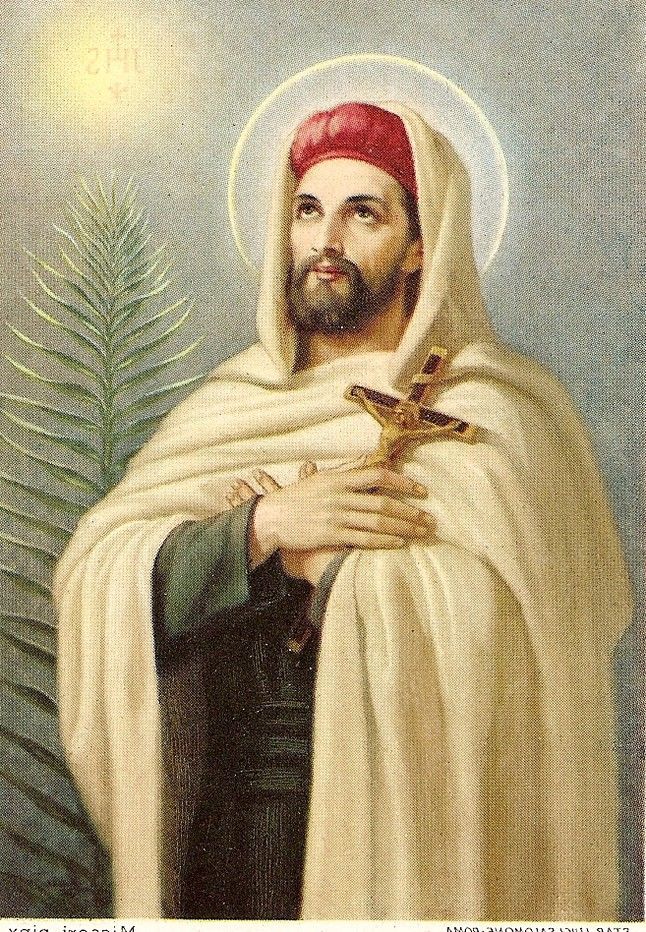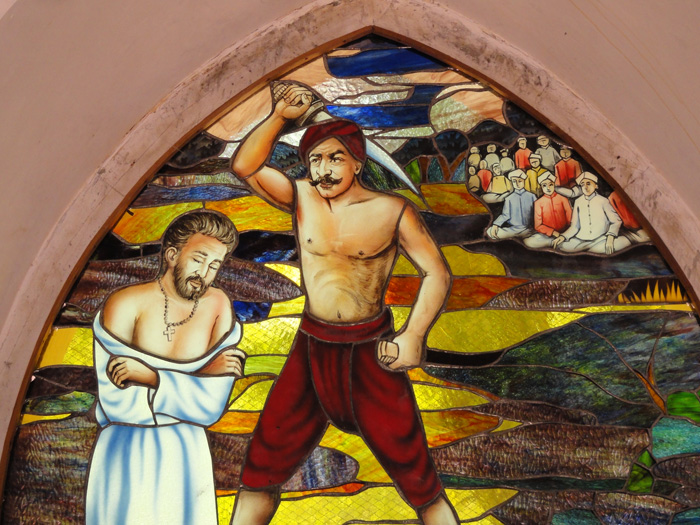Saint John de Britto, SJ
Born : March 1, 1647
Died : February 4, 1693
Beatified : May 18, 1852
Canonized : June 22, 1947
 John de Brito was born in Lisbon, Portugal of Portuguese aristocracy. His father was governor of Rio de Janeiro and John became a member of the royal court when he was nine and was a companion to the young prince who later became King Peter II. At eleven, John almost died of an illness and his mother vowed to St Francis Xavier that her son would wear a Jesuit cassock for a year if he would recover. John recovered shortly and soon was walking around the court like a miniature Jesuit. At the end of one year, John removed his cassock, but by then he was already thinking of becoming a Jesuit. Despite the persuasion from the king and prince to remain at court, John was determined to follow what he saw was God’s will.
John de Brito was born in Lisbon, Portugal of Portuguese aristocracy. His father was governor of Rio de Janeiro and John became a member of the royal court when he was nine and was a companion to the young prince who later became King Peter II. At eleven, John almost died of an illness and his mother vowed to St Francis Xavier that her son would wear a Jesuit cassock for a year if he would recover. John recovered shortly and soon was walking around the court like a miniature Jesuit. At the end of one year, John removed his cassock, but by then he was already thinking of becoming a Jesuit. Despite the persuasion from the king and prince to remain at court, John was determined to follow what he saw was God’s will.
He entered the Jesuit novitiate in Lisbon in December 1662 when he was only fifteen and went to study the classics at Evora College after taking his vows. Later he was transferred to the University of Coimbra because of health problems. There he studied philosophy and developed a special interest in St Francis Xavier and India. Two years later he wrote to Fr General Gian Paolo Olivia, requesting to be sent to the East as a missionary, but first he had to finish his studies for the priesthood which he did in 1673 and was ordained.
As a priest, Fr Brito was preparing to go to India and despite the objection of his mother he left in March, 1673, arriving at Goa, I ndia the following September. He studied more theology in Goa and was asked to remain as a teacher but his reply was: “I came to India not to seek the laurels of science but martyrdom.”
Fr Brito’s first mission was in Madura, in the regions of Kolei and Tattuvanchery. He studied the complex India caste system and discovered that most Christians belonged to the lowest and most despised caste. He knew that for Christianity to have a lasting influence, members of the higher caste would also have to be converted. He became an Indian ascetic, a pandaraswami since they were permitted to approach individuals of all castes, living and dressing as they did. In time he was accepted as a pandaraswami and as his reputation grew so did his conversions. After eleven years on the mission, Fr Brito was made superior in Madura, but because he was successful in converting many to Catholicism, he became the object of hostility from the Brahmans, the highest caste, who resented his work and wanted to kill him. They almost succeeded in 1686 when their soldiers apprehended him and his catechists and had they bound in heavy chains. He was released after a month in prison and got back to Madura. He was given a hero’s welcome on his return to Portugal to report on the status of the mission in India. King Peter II, his childhood friend persuaded him to remain at home to tutor his two sons but Fr Brito placed the needs in India above the comfort of the Portuguese court.
 Fr Brito returned to Goa and to his mission in Madura despite a death threat that the Raja of Marava had made four years earlier. He traveled at night from station to station so he could celebrate Mass and baptise converts. His success in converting Prince Tadaya Theva indirectly led to his death. The prince was interested in Christianity and had a catechist instruct him in the faith but when he fell sick he asked Fr Brito to come and baptize him. Fr Brito insisted that the prince could keep only one of his several wives after his baptism which he agreed, but one of the rejected wives complained to her uncle, the Raja of Marava who sent soldiers to arrest Fr Brito on January 20, 1690. Twenty days later, the Raja exiled Fr Brito to Oriyur, a neighbouring province governed by his brother as his intention was to have Fr Brito executed there.
Fr Brito returned to Goa and to his mission in Madura despite a death threat that the Raja of Marava had made four years earlier. He traveled at night from station to station so he could celebrate Mass and baptise converts. His success in converting Prince Tadaya Theva indirectly led to his death. The prince was interested in Christianity and had a catechist instruct him in the faith but when he fell sick he asked Fr Brito to come and baptize him. Fr Brito insisted that the prince could keep only one of his several wives after his baptism which he agreed, but one of the rejected wives complained to her uncle, the Raja of Marava who sent soldiers to arrest Fr Brito on January 20, 1690. Twenty days later, the Raja exiled Fr Brito to Oriyur, a neighbouring province governed by his brother as his intention was to have Fr Brito executed there.
On January 30, 1693, Fr Brito was led to a peaceful knoll overlooking the river. When he reached the spot selected for his martyrdom, Fr Brito knelt down in prayer. The Raja’s order was publicly read, and when the executioner hesitated to do his job, Fr Brito encouraged him: “My friend, I have prayed to God. On my part, I have done what I should do. Now do your part. Carry out the order you have received.” The executioner aimed the scimitar at the martyr’s neck and the victim’s head fell into the sand. Next his hands and feet were cut off and bound them to the torso and placed it on a stake, where it was left as food for the birds and animals.
